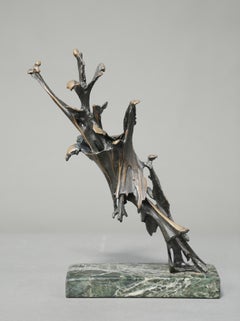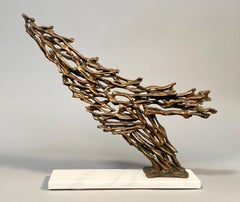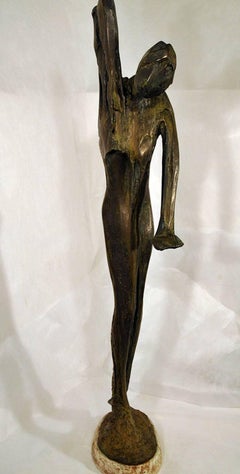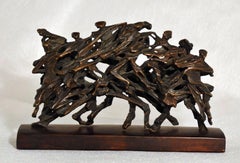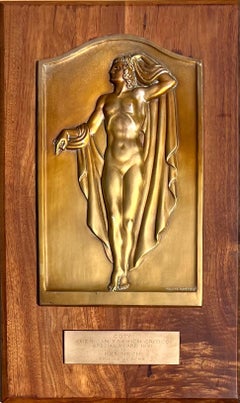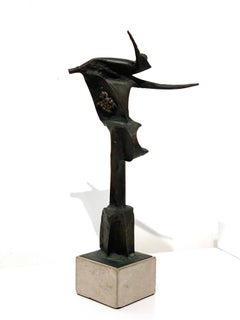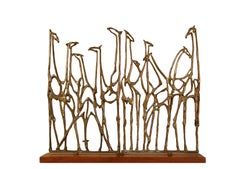Robert Cook Art
to
2
1
1
Overall Width
to
Overall Height
to
3
1
1
1
2
2
2
2
2
2
1
1
4
4
3
1
1
5
10,082
2,770
1,380
1,375
4
Artist: Robert Cook
Splash
By Robert Cook
Located in New York, NY
Robert Cook’s Splash sculpture draws inspiration from the iconic photograph of a drop of milk creating a circle and splash in a pool of milk. This fleeting moment of suspended motion sparked Cook’s exploration of how to capture such dynamic energy in a static form.
Robert Cook was a great American sculptor and his works are in many museums and his iconic Dinoseras piece commands a spot on the street of New York at 51st Street.
Important to note with this work that it is unique and there are no other casts. Cook sculpted in wax and when he cast this destroyed the wax and there was no mould. Very few sculptors work in this manner and it speaks to a very pure and altruistic form of sculpture. If perhaps he had been more commercially minded he would have done large editions but instead he valued singularity as in nature.
In Splash, Cook freezes a moment of kinetic energy, capturing the elegant tension between impact and expansion. The sculpture embodies both grace and chaos, with a fluidity that suggests movement at the very instant it’s frozen in time. Cook’s mastery of his medium allows this dynamic moment to be immortalized in bronze, creating a powerful and emotional resonance that transcends the physical form, making Splash both a formal and philosophical exploration of time, space, and motion.
Signed: R Cook...
Category
1960s Abstract Robert Cook Art
Materials
Stone, Bronze
Rushing
By Robert Cook
Located in New York, NY
Robert Cook’s sculpture Rushing serves as an energetic reflection on the fast-paced nature of life—where so many of us are constantly in motion, hurrying from one place to another. H...
Category
2010s Abstract Robert Cook Art
Materials
Marble, Bronze
$9,500
Up
By Robert Cook
Located in New York, NY
Bronze, 1967. Height 59" (149.9 cm) width max 15" (38 cm).
Signed on base "R Cook." This unique large sculpture was made using the lost wax process.
“ ...
Category
Mid-20th Century American Modern Robert Cook Art
Materials
Stone, Bronze
$35,000
Harlem III
By Robert Cook
Located in New York, NY
Signed, titled, and dated in ink on base verso. Unique sculpture created using the lost wax process. This piece is 7 1/2" high x 12" wide x 3 1/2" deep.
Robert Cook was born in Boston in 1921. He studied with George Demetrios...
Category
1990s Modern Robert Cook Art
Materials
Bronze
Related Items
1961 Coty Award Plaque Kenneth Hairdresser Jacqueline Onassis Bronze Fashion
Located in New York, NY
1961 Coty Award Plaque Kenneth Hairdresser Jacqueline Onassis Bronze Fashion
Bronze on wood. The wood plaque measures 12 3/4" by 20 3/4 inches. The bronze plaque itself is 13 3/4 x 8 3/4 inches and the the bronze inscription, which reads "COTY, American Fashion Critics Special Award 1961 to KENNETH of LILY DACHE...
Category
1960s American Modern Robert Cook Art
Materials
Bronze
Untitled
Located in San Diego, CA
Abstract bronze sculpture by artist Clyde Ball on cast concrete base. Circa 1970's, signed on base. The patina on this piece is dark, with hints of ...
Category
20th Century Abstract Robert Cook Art
Materials
Concrete, Bronze
David Hostetler Polished Bronze Female Form Bust Feminine Shiny Gold Egyptian
By David Hostetler
Located in Nantucket, MA
This polished bronze bust is sealed with Glasurit- a car finish that is baked on. It prevents the sculpture from tarnishing or yellowing. All you need to do is dust with a soft cloth. This bust is from a full figure wood sculpture...
Category
1970s Modern Robert Cook Art
Materials
Bronze
$5,900
H 11.5 in W 7 in D 4 in
Chaim Gross Mid Century Mod Bronze Sculpture Mother and Baby Playing WPA Artist
By Chaim Gross
Located in Surfside, FL
Chaim Gross (American, 1904-1991)
Cast bronze sculpture
Caring (or Mother and Child)
signed
Mounted on wooden plinth
Featuring a mother raising her child up in superb high relied i...
Category
Mid-20th Century American Modern Robert Cook Art
Materials
Bronze
$2,400
H 9 in W 7.5 in D 3.5 in
"Deformation"
By Katib Mamedov
Located in Edinburgh, GB
The sculpture has an abstract form with smooth curves, openings and a mirror-polished surface, which creates the effect of a play of light and reflections. It creates a textured part...
Category
21st Century and Contemporary Abstract Robert Cook Art
Materials
Granite, Bronze
"Lucky Number" - abstract sculpture - Barbara Hepworth
By Susan Hable
Located in Atlanta, GA
Susan Hable is inspired by the work of David Hockney, Milton Avery, Henri Matisse, Alex Katz, Howard Hodgkins, Hilma af Klint, Georgia O'Keeffe, Barbara Hepworth and Constantin Brâncuși.
With humor and a bit of mischief, Susan Hable’s “Don't Pick The Flowers!” is a body of work that is at once a refuge and a playground. Inspired by her sumptuous garden just outside of her Athens studio, Susan flows from one medium to the next from painting to collage to sculpture. Susan sees her garden as a place for adventure and daydreaming, challenging her perceptions of what her Art can be. Even a weedy ground cover has caught Susan’s eye, an overlooked invasive is seen in a new light becoming a dreamlike fairytale path. Her work asks us to engage in life, go for a walk and play.
Susan Hable Smith is the artist and designer behind the boldly colored and hand drawn patterns of Hable Construction...
Category
2010s Abstract Robert Cook Art
Materials
Marble, Bronze
$6,800
H 20 in W 12 in D 12 in
"Nimbus" - abstract sculpture - Barbara Hepworth
By Susan Hable
Located in Atlanta, GA
Susan Hable is inspired by the work of David Hockney, Milton Avery, Henri Matisse, Alex Katz, Howard Hodgkins, Hilma af Klint, Georgia O'Keeffe, Barbara Hepworth and Constantin Brâncuși.
With humor and a bit of mischief, Susan Hable’s “Don't Pick The Flowers!” is a body of work that is at once a refuge and a playground. Inspired by her sumptuous garden just outside of her Athens studio, Susan flows from one medium to the next from painting to collage to sculpture. Susan sees her garden as a place for adventure and daydreaming, challenging her perceptions of what her Art can be. Even a weedy ground cover has caught Susan’s eye, an overlooked invasive is seen in a new light becoming a dreamlike fairytale path. Her work asks us to engage in life, go for a walk and play.
Susan Hable Smith is the artist and designer behind the boldly colored and hand drawn patterns of Hable Construction...
Category
2010s Abstract Robert Cook Art
Materials
Marble, Bronze
La Source (The Stream)
Located in New York, NY
A superb smaller version of a large scale commission work that stands in Bordeaux at the Hotel Fruges! Lovely patina - a lighter but rich and warm brown tone that is rare to see in ...
Category
1920s Modern Robert Cook Art
Materials
Bronze
Arabesque, Female Ballet Dancer in Motion, Bronze Gray Bas Relief Sculpture Art
By Eric Bransby
Located in Denver, CO
This stunning figurative bas relief sculpture captures a female ballet dancer gracefully poised in the arabesque position, created by the acclaimed Colorado/Missouri artist Eric Bransby (1916-2020). Crafted from bronze and polymer Forton casting, the piece beautifully exemplifies Bransby’s mastery of motion and form.
Provenance:
Collection of the artist, Eric Bransby
About Eric Bransby:
Eric James Bransby was a highly respected muralist, painter, illustrator, and educator. His education at the Colorado Springs Fine Art Center included studies with renowned artists like Thomas Hart Benton, Jean Charlot, Boardman Robinson, and Josef Albers. He also studied at the prestigious Yale School of Fine Art.
Bransby’s career is defined by his exceptional work as a muralist, with notable commissions including the Rockhurst Library Triptych Mural at the University of Missouri, murals at Brigham Young University, the U.S. Air Force Academy...
Category
20th Century American Modern Robert Cook Art
Materials
Bronze
$6,400 Sale Price
20% Off
H 40 in W 30 in D 3 in
Milton Hebald Mid Century Bronze Menorah Sculpture WPA Artist Modernist Judaica
Located in Surfside, FL
Milton Hebald (American, 1917-2015)
Lion of Judah menorah
bronze on a white marble plinth base
signed in bronze
12" H x 10.5" W x 2.5" D
Milton Elting Hebald (1917 – 2015) was a s...
Category
1960s American Modern Robert Cook Art
Materials
Marble, Bronze
$6,500
H 12 in W 10.5 in D 2.5 in
Morris Brose "Bronze Bull" Figurative Sculptural Abstract
Located in Detroit, MI
"Bronze Bull" is an exquisite example of Morris Brose's abstract/figurative sculpture. No soft edges on this piece and no invitation to caress, the power, strength and beauty of the bronze are front and center and create awe. "Bronze Bull" is a free-standing piece signed on the base.
Morris Brose, Polish/American was born in Wyszkow, Poland. He became a sculptor and instructor of sculpture at the Detroit Institute of Arts, Wayne State University and Cranbrook Academy of Art, Bloomfield Hills, Michigan. Cranbrook was designed by architect and faculty member, Eliel Saarinen who collaborated with Charles and Ray Eames on chair and furniture design. Numerous creative artists who are alumni of Cranbrook include: Harry Bertoia, Florence Knoll, Jack Lenor Larsen, Donald Lipski...
Category
Late 20th Century Modern Robert Cook Art
Materials
Bronze
$5,500
H 26.5 in W 16 in
Bronze Heron Sculpture by Wayne F Williams
Located in Rochester, NY
Bronze heron by American sculptor Wayne Williams. Signed and dated 1993. Edition 2/2. Mounted on a walnut base.
From Finger Lakes Magazine 2001:
Art is everywhere in the Finger Lakes. Inspired by the region’s diverse scenery and lifestyles, artists pursue their creativity outdoors, in studios and in workshops. In the many well-established museums and galleries or at the newer fledgling arts organizations, a wide array of artistic styles and talents are represented. Often the artists, like Wayne Williams, share their artistic skill and passion through teaching at local colleges.
Williams, who is retired after a 35-year career at Finger Lakes Community College, found his calling there. “I didn’t want to teach in public schools,” explains Williams of his career choice. “I wanted to be at the college level. CCFL (the Community College of the Finger Lakes, as it was then known) was literally creating a college, right from scratch.” The year was 1968 and Williams was charged with coordinating the new college’s art program.
Rand Darrow, a CCFL student in that first year, remembers attending Williams’ art classes in a commercial building on Main Street just south of the railroad tracks in Canandaigua. Darrow appreciated his instructor’s relaxed manner. “He was a great teacher,” recalls Darrow, “cracking jokes all the time.” Darrow graduated with a major in Liberal Arts and continued on to SUNY Oswego where he earned a BA in fine arts. He taught art to elementary and middle school students for 30 years.
These days Williams and Darrow typically cross paths at the Wayne County Arts Council in Newark where Williams and his wife, Marleen, are heavily involved. Williams offers classes in figure drawing and sculpture and hangs the gallery’s shows, including his former student’s “Slavic Tales of Novgorod” this past August. “I’d like to take a sculpture class from him,” says Darrow.
In 2003 when Williams retired, the college honored him and another retiring art professor, Tom Insalaco, by renaming its art gallery the Williams-Insalaco Art Gallery. It was known formerly as Gallery 34 to recognize its origins at 34 North Main Street in Canandaigua. Williams held professor’s rank from 1976 and served as director of the art gallery beginning with its opening in 1983.
Williams, who was born and raised in Newark, New York, says he began doing art at about age 8. By the time he was in junior high school his career direction seemed clear. He received local and national awards for his art and a scholarship to Syracuse University, from which he graduated in 1958 with a Bachelor of Fine Arts in sculpture. He continued with graduate work at Syracuse, receiving an MFA in sculpture in 1962. He worked full time as a sculptor until he began teaching.
At one point Williams admits he wanted to be a painter, but didn’t want to adopt the abstract expressionist style in vogue in the 1950s, preferring to pursue the realist tradition. He advises any would-be artist to “do what you do because you love it.”
After graduation he traveled abroad, spending time in Belgium, the land of his ancestors. “My family’s name was originally Willems,” explains the 73-year old who still relishes the time spent in the Flemish countryside. Williams speaks excitedly about art, referencing the lives of great artists. He acknowledges that American artists do not have the same stature as those in Europe, where Old Masters like Brueghel and Rembrandt are national heroes.
These days the energetic Williams, known primarily as a sculptor, is active at the Phelps Arts Center where he is on the board of directors. In mid-September when a group of visitors on a motor coach tour explored artworks displayed in the beautiful church-turned- gallery, they were treated to a large number of Williams’ bronze and metal sculptures, along with his charcoal drawings. “I’ve always loved his work because he deals with things, people, and animals you understand,” says the center’s Director Emeritus Marion Donnelly, who has known him for many years.
Outside the Phelps Community Historical Society, Williams’ life-size figure of a farmer raises his pitchfork above a colorful flower garden on the front lawn. Inspired by the peasants working the fields in Europe, the metal figure is shown with wooden shoes. This is Williams’ largest copper piece, loaned to the Phelps museum in connection with Artistry in Sculpture, a community exhibition in 2009. Williams added a new base using a metal wagon...
Category
20th Century Modern Robert Cook Art
Materials
Bronze
Previously Available Items
Giraffe Gates, bronze sculpture
By Robert Cook
Located in New York, NY
This unique cast bronze is the perfect work to silhouette in front of a plain wall area. It acts as a line drawing in space. Robert Cook explored the limits of the lost was casting ...
Category
1980s American Modern Robert Cook Art
Materials
Bronze
Virasat Curved, figurative bronze mantle piece
By Robert Cook
Located in New York, NY
A remarkable and unique format bronze of unique cast that could be great for a mantle or console table.
In Robert Cook's book entitled “Waxing and Waning” he discusses three castings...
Category
Early 2000s American Modern Robert Cook Art
Materials
Stone, Bronze
Bronze Sculpture of a Skier
By Robert Cook
Located in Wiscasett, ME
Bronze sculpture of a skier signed on the bottom "R. Cook", great movement in this piece.
Robert Cook is an innovator in the “lost wax” process of casting, creating larger sculptures than had previously been possible. He has a number of major public sculptures in New York...
Category
1960s Modern Robert Cook Art
Materials
Bronze
Dinoceras #3
By Robert Cook
Located in New York, NY
Unique sculpture created using the lost wax process. Signed in bronze. A study leading to the creation of "Dinoceras," a monumental work installed at 345 Park Avenue, New York, in 1971. This piece is 12" high x 16 3/4" wide x 5 1/2" depth.
Robert Cook was born in Boston in 1921. He studied with George Demetrios...
Category
1970s Modern Robert Cook Art
Materials
Stone, Bronze
Icarus
By Robert Cook
Located in New York, NY
Bronze on wood base. 9" high x 7" wide x 3" depth. Signed in bronze. Unique sculpture created using the lost wax process. Artist Robert Cook was born in Boston in 1921. He studied with George Demetrios...
Category
1990s Modern Robert Cook Art
Materials
Bronze
Robert Cook art for sale on 1stDibs.
Find a wide variety of authentic Robert Cook art available for sale on 1stDibs. You can also browse by medium to find art by Robert Cook in bronze, metal, stone and more. Much of the original work by this artist or collective was created during the 20th century and is mostly associated with the modern style. Not every interior allows for large Robert Cook art, so small editions measuring 12 inches across are available. Customers who are interested in this artist might also find the work of Stanley Bleifeld, Suzan Etkin, and Dudley Vaill Talcott. Robert Cook art prices can differ depending upon medium, time period and other attributes. On 1stDibs, the price for these items starts at $6,500 and tops out at $35,000, while the average work can sell for $9,100.
